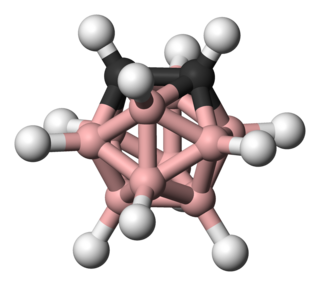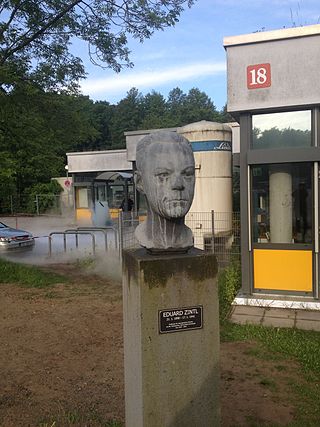Related Research Articles
In chemistry, the oxidation state, or oxidation number, is the hypothetical charge of an atom if all of its bonds to other atoms were fully ionic. It describes the degree of oxidation of an atom in a chemical compound. Conceptually, the oxidation state may be positive, negative or zero. While fully ionic bonds are not found in nature, many bonds exhibit strong ionicity, making oxidation state a useful predictor of charge.

Carboranes are electron-delocalized clusters composed of boron, carbon and hydrogen atoms. Like many of the related boron hydrides, these clusters are polyhedra or fragments of polyhedra. Carboranes are one class of heteroboranes.

In chemistry, cryptands are a family of synthetic, bicyclic and polycyclic, multidentate ligands for a variety of cations. The Nobel Prize for Chemistry in 1987 was given to Donald J. Cram, Jean-Marie Lehn, and Charles J. Pedersen for their efforts in discovering and determining uses of cryptands and crown ethers, thus launching the now flourishing field of supramolecular chemistry. The term cryptand implies that this ligand binds substrates in a crypt, interring the guest as in a burial. These molecules are three-dimensional analogues of crown ethers but are more selective and strong as complexes for the guest ions. The resulting complexes are lipophilic.
In chemistry the polyhedral skeletal electron pair theory (PSEPT) provides electron counting rules useful for predicting the structures of clusters such as borane and carborane clusters. The electron counting rules were originally formulated by Kenneth Wade, and were further developed by others including Michael Mingos; they are sometimes known as Wade's rules or the Wade–Mingos rules. The rules are based on a molecular orbital treatment of the bonding. These rules have been extended and unified in the form of the Jemmis mno rules.
In chemistry, a Zintl phase is a product of a reaction between a group 1 or group 2 and main group metal or metalloid. It is characterized by intermediate metallic/ionic bonding. Zintl phases are a subgroup of brittle, high-melting intermetallic compounds that are diamagnetic or exhibit temperature-independent paramagnetism and are poor conductors or semiconductors.

Eduard Zintl was a German chemist. He gained prominence for research on intermetallic compounds.

Caesium dodecaborate is an inorganic compound with the formula Cs2B12H12. It is a salt composed of caesium and dodecaborate(12) ions. The [B12H12]2− anion has been of great theoretical interest to the chemistry community.
In organometallic chemistry, a transition metal indenyl complex is a coordination compound that contains one or more indenyl ligands. The indenyl ligand is formally the anion derived from deprotonation of indene. The η5-indenyl ligand is related to the η5cyclopentadienyl anion (Cp), thus indenyl analogues of many cyclopentadienyl complexes are known. Indenyl ligands lack the 5-fold symmetry of Cp, so they exhibit more complicated geometries. Furthermore, some indenyl complexes also exist with only η3-bonding mode. The η5- and η3-bonding modes sometimes interconvert.

Plumbide is an anion of lead atoms. There are three plumbide anions, written as Pb−, Pb2− and Pb4− with 3 oxidation states, -1, -2 and -4, respectively. A plumbide can refer to one of two things: an intermetallic compound that contains lead, or a Zintl phase compound with lead as the anion.

Eluvathingal Devassy Jemmis is a professor of theoretical chemistry at the Indian Institute of Science, Bangalore, India. He was the founding director of Indian Institute of Science Education and Research, Thiruvananthapuram (IISER-TVM). His primary area of research is applied theoretical chemistry with emphasis on structure, bonding and reactivity, across the periodic table of the elements. Apart from many of his contributions to applied theoretical chemistry, an equivalent of the structural chemistry of carbon, as exemplified by the Huckel 4n+2 Rule, benzenoid aromatics and graphite, and tetrahedral carbon and diamond, is brought in the structural chemistry of boron by the Jemmis mno rules which relates polyhedral and macropolyhedral boranes to allotropes of boron and boron-rich solids. He has been awarded Padma Shri in Science and Engineering category by the Government of India.
John Dudley Corbett was an American chemist who specialized in inorganic solid-state chemistry. At Iowa State and Ames Lab, Corbett lead a research group that focused on the synthesis and characterization of two broad classes of materials, notably Zintl phases and condensed transition metal halide clusters. Both classes of materials are important for their uses, for instance thermoelectrics, and for the theoretical advances they made possible by working to understand their complex bonding and electronic properties.
In chemistry, the Jemmis mno rules represent a unified rule for predicting and systematizing structures of compounds, usually clusters. The rules involve electron counting. They were formulated by E. D. Jemmis to explain the structures of condensed polyhedral boranes such as B20H16, which are obtained by condensing polyhedral boranes by sharing a triangular face, an edge, a single vertex, or four vertices. These rules are additions and extensions to Wade's rules and polyhedral skeletal electron pair theory. The Jemmis mno rule provides the relationship between polyhedral boranes, condensed polyhedral boranes, and β-rhombohedral boron. This is similar to the relationship between benzene, condensed benzenoid aromatics, and graphite, shown by Hückel's 4n + 2 rule, as well as the relationship between tetracoordinate tetrahedral carbon compounds and diamond. The Jemmis mno rules reduce to Hückel's rule when restricted to two dimensions and reduce to Wade's rules when restricted to one polyhedron.

In the area of metal cluster chemistry, a butterfly cluster compound usually describes tetrametallic clusters containing five M-M bonds. A prototype of this motif is [Re4(CO)16]2−. Most butterfly clusters have additional bridging ligands. One example is the pentaphosphide [[Rh4(CO)5(PPh2)5]]− where all Rh---Rh edges are bridged by PPh2. A carbide-containing butterfly cluster is [Fe4C(CO)12]2− where the carbide is bonded to all four Fe centers.

Metal cluster compounds are a molecular ion or neutral compound composed of three or more metals and featuring significant metal-metal interactions.
A silicide hydride is a mixed anion compound that contains silicide (Si4− or clusters) and hydride (H−) anions. The hydrogen is not bound to silicon in these compounds. These can be classed as interstitial hydrides, Hydrogenated zintl phases, or Zintl phase hydrides. In the related silanides, SiH3− anions or groups occur. Where hydrogen is bonded to the silicon, this is a case of anionic hydride, and where it is bonded to a more complex anion, it would be termed polyanionic hydride.
Arsenidosilicates are chemical compounds that contain anions with arsenic bonded to silicon. They are in the category of tetrelarsenides, pnictidosilicates, or tetrelpnictides. They can be classed as Zintl phases or intermetallics. They are analogous to the nitridosilicates, phosphidosilicates, arsenidogermanates, and arsenidostannates. They are distinct from arsenate silicates which have oxygen connected with arsenic and silicon, or arsenatosilicates with arsenate groups sharing oxygen with silicate.
Arsenidostanates are chemical compounds that contain anions with arsenic bonded to tin. They are in the category of tetrelarsenides, pnictidostancates, or tetrelpnictides.
Thallides are compounds containing anions composed of thallium. There are several thallium atoms in a cluster, and it does not occur as a single Tl− in thallides. They are a subclass of trielides, which also includes gallides and indides. A more general classification is polar intermetallics, as clusters contain delocalized multicentre bonds. Thallides were discovered by Eduard Zintl in 1932.
Under standard conditions, the elements dysprosium and tin combine to form a number of intermetallic compounds, the dysprosium stannides. Dysprosium stannides with simple empirical formulas include Dy5Sn3 and DySn2, but four other intermetallics have intermediate composition. None is believed to survive temperatures higher than 1,866 °C (3,391 °F), whereat Dy5Sn3 decomposes. Although dysprosium is a lanthanoid, its f orbitals likely participate in the metallic bonding: mixing dysprosium and tin releases an enthalpy quite different from mixing samarium and tin, with gadolinium and tin intermediate.
Yttrium and tin form several yttrium stannide intermetallic compounds.
References
- ↑ Flacke, F.; Jacobs, H. (1997). "[Li(NH3)4] [Sn(SnPh3)3].C6H6, Crystal structure of a stannide with trigonal pyramidal tin skeleton". European Journal of Solid State and Inorganic Chemistry. 34 (5): 495–501.
- 1 2 3 4 5 S.M. Kauzlarich,(1994), Zintl Compounds, Encyclopedia of Inorganic Chemistry, John Wiley & sons, ISBN 0-471-93620-0
- 1 2 Hoch, C.; Wendorff, M.; Röhr, C. (2002). "Tetrapotassium nonastannide, K4Sn9". Acta Crystallogr C. 58 (4): i45–i46. Bibcode:2002AcCrC..58I..45H. doi:10.1107/S0108270102002032. PMID 11932511.
- ↑ Klem, M. T.; Vaughey, J. T.; Harp, J G.; Corbett, J D. (2001). "A3Tt5 Phases Sr3Sn5, Ba3Pb5, and La3Sn5. Structure and Bonding in a Series of Isotypic Metallic Compounds with Increased Electron Count and Their Comparison with the Nominal Zintl Phase La3In5". Inorg. Chem. 40 (27): 7020–7026. doi:10.1021/ic010804v. PMID 11754285.
- ↑ Sreeraj, P; Johrendt, D.; Müller, H.; Hoffmann, R.-D.; Wu, Zhiyun; Pöttgen, R. (2005). "The stannide LiRh3Sn5: Synthesis, structure, and chemical bonding". Zeitschrift für Naturforschung B. 60 (9): 933–939. doi: 10.1515/znb-2005-0904 . S2CID 197000256.
- ↑ Schlüter, M.; Kunst, A.; Pöttgen, R. (2002). "The Ternary Stannides MgRuSn4 and MgxRh3Sn7−x (x = 0.98–1.55)". Zeitschrift für anorganische und allgemeine Chemie. 628 (12): 2641–2646. doi:10.1002/1521-3749(200212)628:12<2641::aid-zaac2641>3.0.co;2-y.
- ↑ Greenwood, Norman N.; Earnshaw, Alan (1997). Chemistry of the Elements (2nd ed.). Butterworth-Heinemann. ISBN 978-0-08-037941-8.
- ↑ Yong, Li; Stephan D. Hoffmann; Thomas F. Fässler (1 December 2006). "A low-dimensional arrangement of [Pb9]4− clusters in [K(18-crown-6)]2K2Pb9·(en)1.5". Inorganica Chimica Acta. 359 (15). Elsevier: 4774–4778. doi:10.1016/j.ica.2006.04.017.
- ↑ Critchlow, S. C.; Corbett, J. D. (1981). "Stable homopolyatomic anions: the tetrastannide (2–) and tetragermanide(2–) anions, Sn2−
4 and Ge2−
4 X-ray crystal structure of [K+(crypt)]
2Sn2−
4. ethylenediamine". J. Chem. Soc. Chem. Commun. 1981 (5): 236–237. doi:10.1039/C39810000236. - ↑ Edwards, P. A.; Corbett, J. D. (1977). "Stable homopolyatomic anions. Synthesis and crystal structures of salts containing the pentaplumbide(2−) and pentastannide(2−) anions". Inorg. Chem. 16 (4): 903–907. doi:10.1021/ic50170a036.
- ↑ Dubois, F.; Schreyer, M.; Fässler, T. F. (2005). "NaSn2: A Novel Binary Zintl Phase with 2D Polyanions of Realgar-Type Units [Sn8]4−". Inorg. Chem. 44 (3): 477–479. doi:10.1021/ic048770p. PMID 15679372.
- ↑ Diehl, L.; Khodadadeh, K.; Kummer, D.; Strähle, J. (1976). "Anorganische Polyederverbindungen, III. Zintl's Polyanionige Salze: Darstellung und Eigenschaften der kristallinen Verbindungen [Na4·7 en]Sn9, [Na4·5 en]Ge9 und [Na3·4 en]Sb7 und ihrer Lösungen Die Kristallstruktur von [Na4·7 en]Sn9". Chemische Berichte. 109 (100): 3404–3418. doi:10.1002/cber.19761091018.
- ↑ Critchlow, S. C.; Corbett, J. D. (1983). "Homopolyatomic anions. The synthesis and characterization of the novel paramagnetic nonastannide(3−) anion Sn3−
9, a D3h cluster with 21 skeletal electrons". J. Am. Chem. Soc. 105 (17): 5715–5716. doi:10.1021/ja00355a045. - ↑ .Fässler, T.F.; Hoffmann, S. (2003). "Na7Sn12: A Binary Zintl Phase with a Two-Dimensional Covalently Bonded Tin Framework". Inorg. Chem. 42 (18): 5474–5476. doi:10.1021/ic030148u. PMID 12950190.